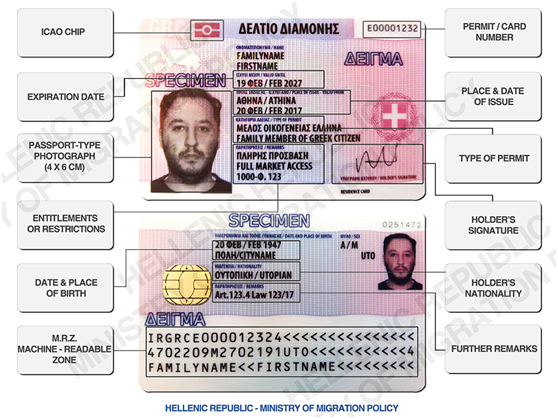Presentation of the new electronic residence permit
The electronic residence permit
Since February 2017, residence permits have changed form and now are autonomous from passports, with biometric data which make them more difficult to forge. This change was made because it was imposed by a Regulation of the European Union (EC 1030/2002 with amendment of EC 380/2002) in all countries.
What are the biometric features?
The biometric features are unique, measurable elements used to identify a person’s identity. Such elements are the face (e.g. the distance between eyes, nose, mouth and ears) and fingerprints.
At a press conference that was held last autumn, the Ministry of Migration Policy explained somewhat more in detail what this card has on it and what information it contains.
Note: It is not yet determined whether people who have this card can deal with public services or banks without their passports.

What does the new electronic residence permit contain?
- It has biographical data, that is, data concerning the name, the category of the permit issued, when the card holder was born, what is his/her nationality, what passport they have, as well as comments (eg access to work)
- On the upper right, there is the number of the electronic residence permit
- On the bottom right, there is a physical signature that has been scanned and printed on it, which means that this signature is not electronic and cannot be read through the chip
- On the top left, the ICAO symbol means that this card includes a wireless chip of the corresponding technology of the intact Bank cards. But that does not mean that you can read the data intact like bank cards
- On the lower part of the back side there is the machine-readable zone. Just like in passports, that is the point from which data can be read from airports, hotels etc.
- There is a second color photograph on the back of the card as a security measure
- There is also the nationality of the holder and further comments where, as a rule, the law articles show the category of authorization to facilitate reading and access rights that the holder may have
Within the electronic residence permit, one can read from the card digitally the owner’s photo, as well as two digitally scanned fingerprints, which are usually the two index fingers.
The biometric data on residence permits are, according to the Ministry, very well protected, with no risk at this time to be lost or read beyond specific access points. This means that Greece must give authorization for the data to be read by a citizen of another EU country.
Here you can read the detailed presentation made by the Ministry (in Greek): http://bit.ly/2BM8uDa

 Ελληνικά
Ελληνικά

